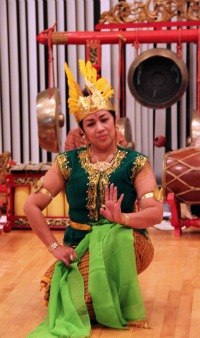W&M Gamelan Ensembles perform with guest artists from the Indonesian Embassy
Gamelan comes from the Javanese word gamel, meaning "to strike or hammer.” Originating in Central Java, a gamelan is a set of kettle gongs, hanging bronze gongs, and xylophones on beautifully carved and painted wooden stands. The College of William & Mary has its own gamelan ensemble, housed in the Bozarth Garage on Armistead Street. It’s there that students learn to play Indonesian gamelan under the instruction of Cynthia Benton-Groner.
The William & Mary Gamelan Ensemble began in January 1999, when composer Vincent McDermott arrived at the College and asked the music department to offer a class for beginners. Benton-Groner began working at the College in 2003, and in 2004 the first William & Mary Freeman Grant allowed for the purchase of the College’s own set of instruments.
“Indonesians believe that anyone can learn to play gamelan,” said
Benton-Groner. “Students who already have a strong music background when they
take up gamelan have to put aside any preconceived notions about music. For
example, there is no strong down beat and no harmonic basis to gamelan music.
Pieces are structured by repeating cycles of melodies that are marked by the
deep sound of the gong ageng.” 
Unlike many other music classes, there are no prerequisites or auditions for the introductory class of gamelan. Anyone enrolled at the College can participate. Students can even fulfill the General Education Requirement 6 by taking two semester of gamelan performance.
Every semester, the William & Mary Gamelan Ensemble hosts one concert in which both the beginner and intermediate groups perform five to six pieces. The two groups performed on November 15 during International Education Week, with special guest performers from the Indonesian Embassy.
“In Java, gamelan is intricately connected with dance, drama, and puppetry. Since there is no instruction in Indonesian dance on campus, we invited dancers from the Embassy to perform with us,” said Benton-Groner.
Next semester the William & Mary Gamelan Ensemble will hold its spring performance with special guest Midiyanto, who teaches at University of California, Berkeley, Singapore, and Central Java. This is a return to Williamsburg for Midiyanto, who came to W&M in 2006 to name the gamelan.
“This set of instruments had never been given a name and I felt it was important that a name be bestowed on it after it was officially acquired by the College,” explained Benton-Groner. “We did this with a traditional Javanese ‘selametan’ ceremony with Javanese food and music.
“The name Midayanto selected -- Tunjung Baskara -- means “Sun Lotus” and reflects the bright sound of this particular gamelan as well as the shiny polish of the bronze.”















